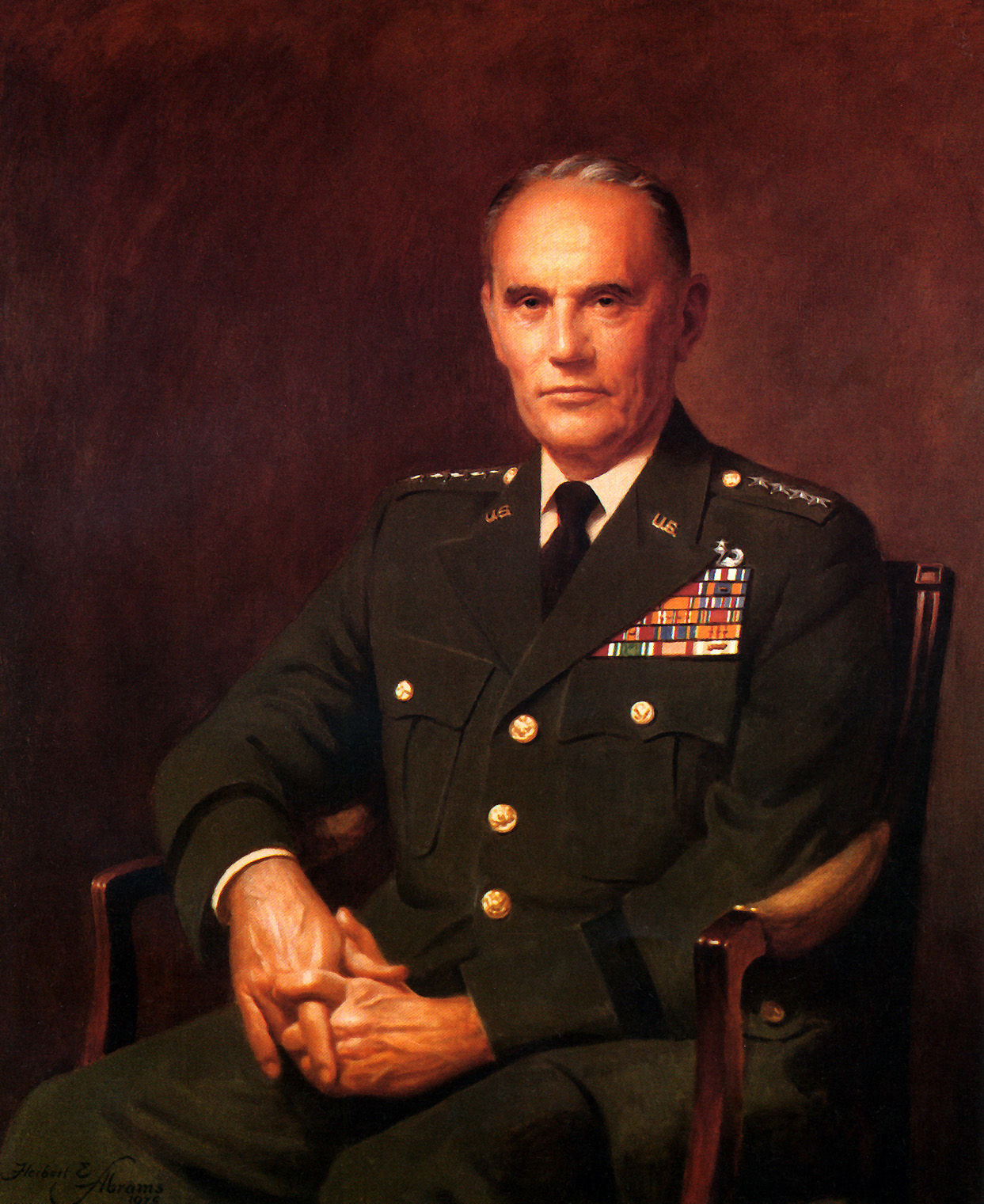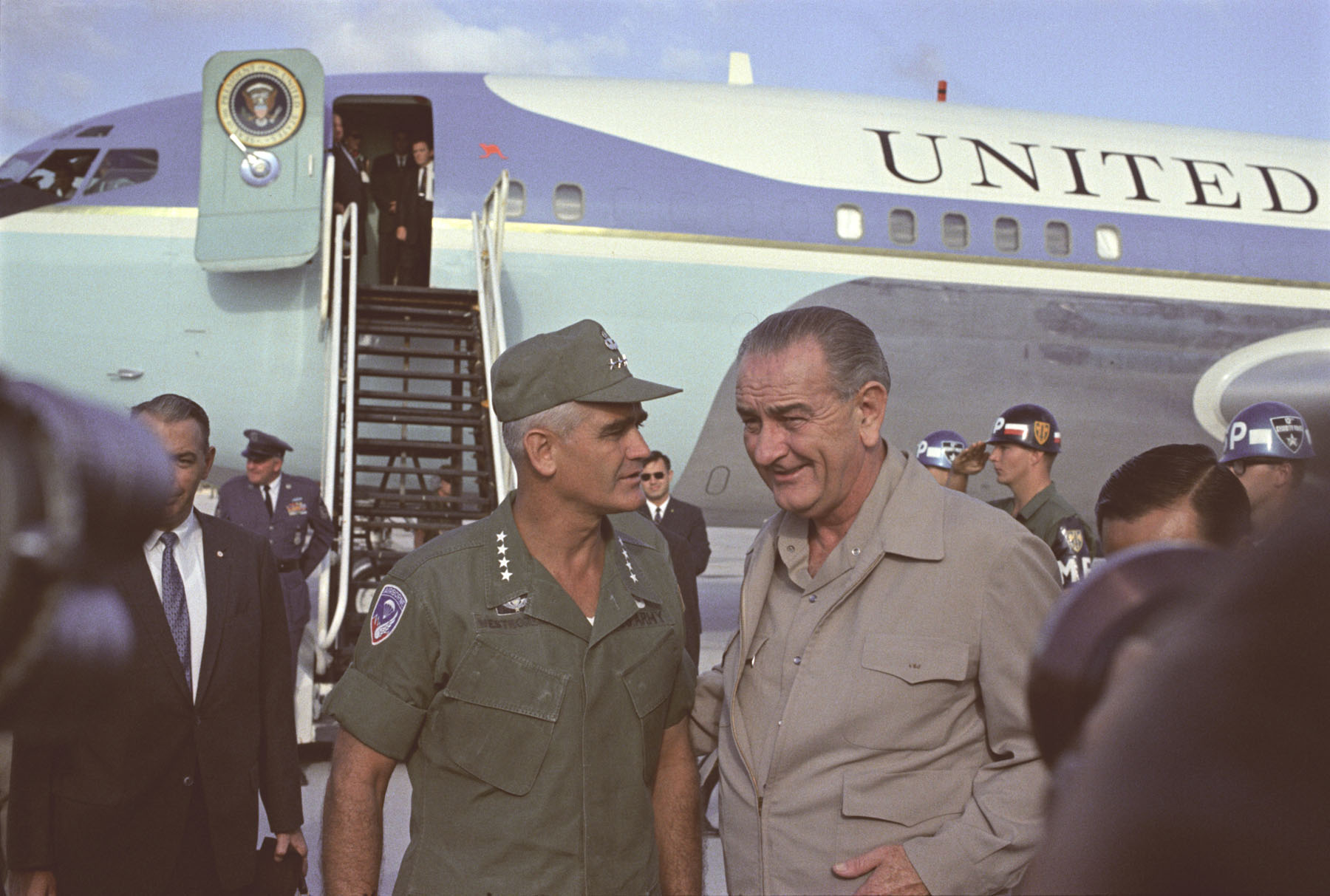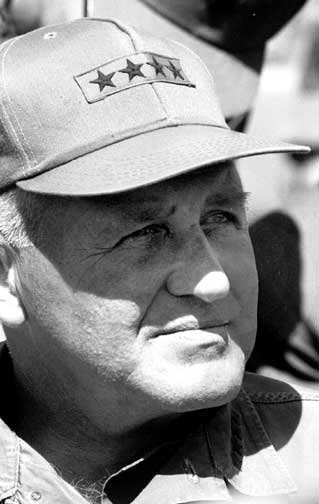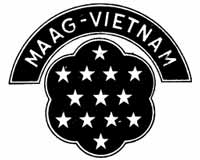|
MACV
U.S. Military Assistance Command, Vietnam (MACV) was a joint-service command of the United States Department of Defense. MACV was created on 8 February 1962, in response to the increase in United States military assistance to South Vietnam. MACV was first implemented to assist the Military Assistance Advisory Group (MAAG) Vietnam, controlling every advisory and assistance effort in Vietnam, but was reorganized on 15 May 1964 and absorbed MAAG Vietnam to its command when combat unit deployment became too large for advisory group control. MACV was disestablished on 29 March 1973 and replaced by the Defense Attaché Office (DAO), Saigon. The DAO performed many of the same roles of MACV within the restrictions imposed by the Paris Peace Accords until the Fall of Saigon. The first commanding general of MACV (COMUSMACV), General Paul D. Harkins, was also the commander of MAAG Vietnam, and after reorganization was succeeded by General William C. Westmoreland in June 1964, followed by Ge ... [...More Info...] [...Related Items...] OR: [Wikipedia] [Google] [Baidu] |
United States Army Vietnam
United States Army Republic of Vietnam (USARV) was a corps-level support command of the United States Army in the Vietnam War. Establishment Although the U.S. Army Support Group was the Army component command within Military Assistance Command, Vietnam (MACV) in 1962, its functions were limited to logistical and administrative matters and excluded operational matters, which were the concern of the chief of Military Assistance Advisory Group, Vietnam. Neither headquarters could qualify as a true Army ground component command. In late 1964 and early 1965, when a major buildup of U.S. Army ground combat forces in South Vietnam was imminent, planners from U.S. Army, Pacific and the Department of the Army began to restudy current command arrangements. The ever-growing responsibilities of the Army Support Command, especially its duties as the U.S. Army component headquarters, precluded its reorganization into a logistical command, as envisaged in contingency plans. These developmen ... [...More Info...] [...Related Items...] OR: [Wikipedia] [Google] [Baidu] |
Defense Attaché Office, Saigon (1973–1975)
The Defense Attaché Office, Saigon (also known as DAO, Saigon or simply DAO) was a joint-service command and military attaché branch of the United States Department of Defense (DOD) under the control of United States Support Activities Group (USSAG). It assumed all DOD responsibilities in South Vietnam following the disestablishment of Military Assistance Command, Vietnam (MACV) in March 1973. The DAO was responsible for administering military assistance and support to the South Vietnamese armed forces, the gathering and distribution of military intelligence and the performance of normal Defense Attaché functions. The DAO remained in existence until August 1975. Background and structure Under the terms of the Paris Peace Accords MACV and all American and third country forces had to be withdrawn from South Vietnam within 60 days of the ceasefire. A small U.S. military headquarters was needed to continue the military assistance program for the South Vietnamese military and superv ... [...More Info...] [...Related Items...] OR: [Wikipedia] [Google] [Baidu] |
1st Logistics Command
The 1st Theater Sustainment Command (1st TSC) is a major subordinate unit of United States Army Central at Fort Knox, Kentucky, United States. History The 1st Logistical Command was activated as a planning headquarters in October 1950 at Fort McPherson, Georgia. During the Berlin Crisis of 1961, the new unit deployed to France to organize the base Logistics Command, which was responsible for the supervision of seven depots and area port operations in western and southwestern France. On August 11, 1962, the 1st Logistical Command returned to the United States where it was reassigned to III Corps at Fort Hood, Texas. Once at Fort Hood, the 1st Logistical Command resumed training and participated in a wide range of logistical missions. Vietnam War Background As early as 1962, the need for a centralized U.S. logistical organization in South Vietnam was foreseen by Commander U.S. Military Assistance Advisory Group, Vietnam, Lieutenant General Paul D. Harkins. The proposal was disap ... [...More Info...] [...Related Items...] OR: [Wikipedia] [Google] [Baidu] |
William Westmoreland
William Childs Westmoreland (March 26, 1914 – July 18, 2005) was a United States Army general, most notably commander of United States forces during the Vietnam War from 1964 to 1968. He served as Chief of Staff of the United States Army from 1968 to 1972. Westmoreland adopted a strategy of attrition against the Viet Cong and the North Vietnamese Army, attempting to drain them of manpower and supplies. He also made use of the United States' edge in artillery and air power, both in tactical confrontations and in relentless strategic bombing of North Vietnam. Nevertheless, public support for the war eventually diminished, especially after the Battle of Khe Sanh and the Tet Offensive in 1968. By the time he was re-assigned as Army Chief of Staff, United States military forces in Vietnam had reached a peak of 535,000 personnel. Westmoreland's strategy was ultimately politically unsuccessful. Growing United States casualties and the draft undermined United States support for the wa ... [...More Info...] [...Related Items...] OR: [Wikipedia] [Google] [Baidu] |
Creighton Abrams
Creighton Williams Abrams Jr. (September 15, 1914 – September 4, 1974) was a United States Army general who commanded military operations in the Vietnam War from 1968 to 1972, which saw United States troop strength in South Vietnam reduced from a peak of 543,000 to 49,000. He was then Chief of Staff of the United States Army from 1972 until his death in 1974. In 1980, the United States Army named its then new main battle tank, the M1 Abrams, after him. The IG Farben building in Germany was also named after Abrams from 1975 to 1995. Military career Early career Abrams graduated from the United States Military Academy at West Point in the Class of 1936 (ranked 185th of 276 in the class), and served with the 1st Cavalry Division from 1936 to 1940, being promoted to first lieutenant in 1939 and temporary captain in 1940. Abrams became an armor officer early in the development of that branch and served as a tank company commander in the 1st Armored Division in 1940. World W ... [...More Info...] [...Related Items...] OR: [Wikipedia] [Google] [Baidu] |
Military Assistance Advisory Group
Military Assistance Advisory Group (MAAG) is a designation for United States military advisors sent to other countries to assist in the training of conventional armed forces and facilitate military aid. Although numerous MAAGs operated around the world throughout the 1940s–1970s, including in Yugoslavia after 1951, the most famous MAAGs were those active in Southeast Asia before and during the Vietnam War. Typically, the personnel of MAAGs were considered to be technical staff attached to, and enjoying the privileges of, the US diplomatic mission in a country. "The special status of personnel serving in Military Advisory Assistance Groups (MAAG) results from their position as an integral part of the Embassy of the United States where they perform duty." Although the term is not as widespread as it once was, the functions performed by MAAGs continue to be performed by successor organizations attached to embassies, often called United States Military Groups (USMILGP or MILGRP). ... [...More Info...] [...Related Items...] OR: [Wikipedia] [Google] [Baidu] |
173d Airborne Brigade
The 173rd Airborne Brigade ("Sky Soldiers") is an airborne infantry brigade combat team (IBCT) of the United States Army based in Vicenza, Italy. It is the United States European Command's conventional airborne strategic response force for Europe.The 173rd Airborne Brigade History, Our History skysoldiers.army.mil, last accessed 21 December 2020 Activated in 1915, as the 173rd Infantry Brigade, the unit saw service in but is best known for its actions during the . The brigade was the first major United States Army ground f ... [...More Info...] [...Related Items...] OR: [Wikipedia] [Google] [Baidu] |
Fall Of Saigon
The Fall of Saigon, also known as the Liberation of Saigon by North Vietnamese or Liberation of the South by the Vietnamese government, and known as Black April by anti-communist overseas Vietnamese was the capture of Saigon, the capital of South Vietnam, by the People's Army of Vietnam (PAVN) and the National Liberation Front of South Vietnam (Viet Cong) on 30 April 1975. The event marked the end of the Vietnam War and the start of a transition period from the formal reunification of Vietnam into the Socialist Republic of Vietnam. The PAVN, under the command of General Văn Tiến Dũng, began their final attack on Saigon on 29 April 1975, with the Army of the Republic of Vietnam (ARVN) forces commanded by General Nguyễn Văn Toàn suffering a heavy artillery bombardment. By the afternoon of the next day, the PAVN and the Viet Cong had occupied the important points of the city and raised their flag over the South Vietnamese presidential palace. The capture of the ci ... [...More Info...] [...Related Items...] OR: [Wikipedia] [Google] [Baidu] |
United States Pacific Command
United States Indo-Pacific Command (USINDOPACOM) is a unified combatant command of the United States Armed Forces responsible for the Indo-Pacific region. Formerly known as United States Pacific Command (USPACOM) since its inception in 1947, the command was renamed to U.S. Indo-Pacific Command in 2018, in recognition of the increasing connectivity between the Indian and Pacific oceans. It is the oldest and largest of the unified combatant commands. Its commander, the senior U.S. military officer in the Pacific, is responsible for military operations in an area that encompasses more than , or roughly 52 percent of the Earth's surface, stretching from the waters of the West Coast of the United States to the east coast maritime borderline waters of Pakistan at the meridian 66° longitude east of Greenwich and from the Arctic to the Antarctic. The commander reports to the President of the United States through the Secretary of Defense and is supported by service component and sub ... [...More Info...] [...Related Items...] OR: [Wikipedia] [Google] [Baidu] |
1st Infantry Division (United States)
The 1st Infantry Division is a combined arms division of the United States Army, and is the oldest continuously serving division in the Regular Army. It has seen continuous service since its organization in 1917 during World War I. It was officially nicknamed "The Big Red One" (abbreviated "BRO") after its shoulder patch and is also nicknamed "The Fighting First." The division has also received troop monikers of "The Big Dead One" and "The Bloody First" as puns on the respective officially sanctioned nicknames. It is currently based at Fort Riley, Kansas. World War I A few weeks after the American entry into World War I, the First Expeditionary Division, later designated the 1st Infantry Division, was constituted on 24 May 1917, in the Regular Army, and was organized on 8 June 1917, at Fort Jay, on Governors Island in New York harbor under the command of Brigadier General William L. Sibert, from Army units then in service on the Mexico–United States border and at various A ... [...More Info...] [...Related Items...] OR: [Wikipedia] [Google] [Baidu] |
South Vietnam
South Vietnam, officially the Republic of Vietnam ( vi, Việt Nam Cộng hòa), was a state in Southeast Asia that existed from 1955 to 1975, the period when the southern portion of Vietnam was a member of the Western Bloc during part of the Cold War after the 1954 division of Vietnam. It first received international recognition in 1949 as the State of Vietnam within the French Union, with its capital at Saigon (renamed to Ho Chi Minh City in 1976), before becoming a republic in 1955. South Vietnam was bordered by North Vietnam to the north, Laos to the northwest, Cambodia to the southwest, and Thailand across the Gulf of Thailand to the southwest. Its sovereignty was recognized by the United States and 87 other nations, though it failed to gain admission into the United Nations as a result of a Soviet veto in 1957. It was succeeded by the Republic of South Vietnam in 1975. The end of the Second World War saw anti-Japanese Việt Minh guerrilla forces, led by communist fi ... [...More Info...] [...Related Items...] OR: [Wikipedia] [Google] [Baidu] |
Gallantry Cross (Vietnam)
The Republic of Vietnam Gallantry Cross also known as the Vietnamese Gallantry Cross or Vietnam Cross of Gallantry ( vi, Anh-Dũng Bội-Tinh) is a military decoration of the former Government of South Vietnam (Republic of Vietnam). The medal was created on August 15, 1950 and was awarded to military personnel, civilians, and Armed Forces units and organizations in recognition of deeds of valor or heroic conduct while in combat with the enemy. Individuals who received the medal, ribbon, and a citation were personally cited at the Armed Forces, Corps, Division, Brigade or Regiment level. The Republic of Vietnam authorized members of units and organizations that were cited, to wear the Gallantry Cross Unit Citation Emblem with Palm and Frame (no medal is authorized). Medal The medal is gold in color, and 35 mm wide. It consists of a Celtic cross with two crossed swords between the arms. The cross is superimposed over a wreath. The center of the cross contains a disc with the ... [...More Info...] [...Related Items...] OR: [Wikipedia] [Google] [Baidu] |






.png)